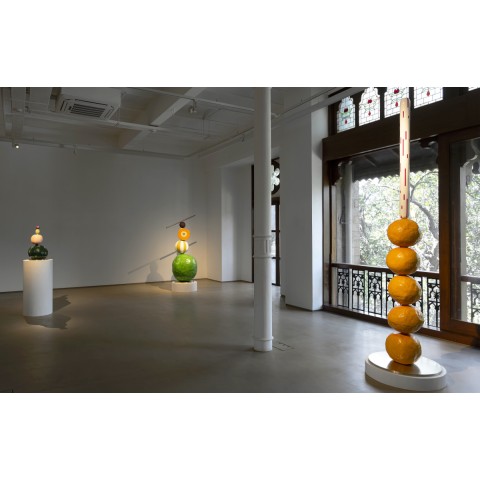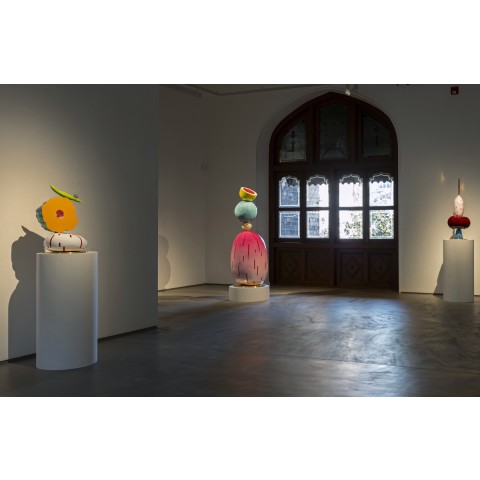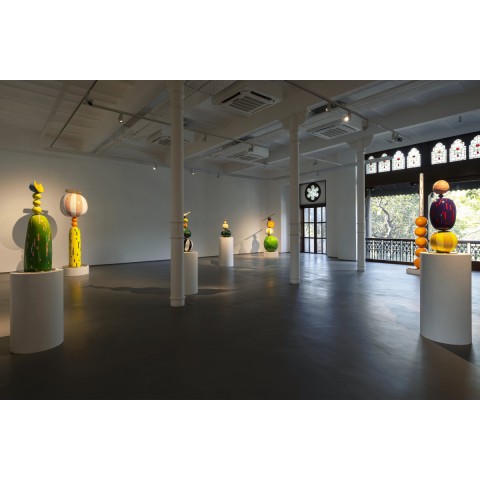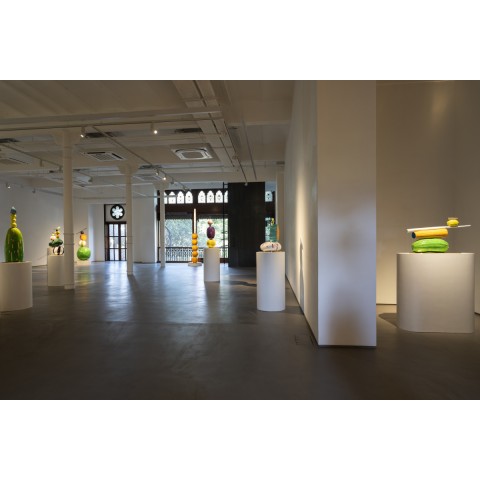
ACID DISCO: JONATHAN TRAYTE
March 13 - April 19 , 2025
What’s common to a gargantuan marrow grown by a hobbyist farmer in Hallam near the thriving market town of Newark in Nottinghamshire, competing to win big at a local horticultural show; a beast of a tungsten inert gas (TIG) welding machine; and paints traditionally meant to spray cars in spanking new colours? These are tools of the trade that artist Jonathan Trayte employs to create imposing bronze sculptures of startlingly intense chromatic expression.
These heavily saturated, hybridised forms are ripe enough for the viewer to develop a heady, sybarite appetite: they germinate and fruit into morphing and mutating orbs and quenelles, their bulbous bodies springing into appendages that appear deliciously off-kilter. Did a tangerine just grow anxious and sprout a Curaçao-hued watermelon? Why is a pinecone teetering atop a luridly sinister green melon? Is that shaft-like chunk of taro encased in saccharinely sticky pink candy? In all their bold-brash-boisterous volume and jarring pronouncements, they evoke the semblance and mouthfeel of cherry pop soda, limonata fizz, scallion schmear, slime cake, Jell-O shots, persimmon pudding, spongy mass of sickly-sweet frosted hell… take your pick. A glut to sink your teeth into, acquired taste notwithstanding.
n Jonathan's compositions we contend with what is natural or artificial, cultivated or manipulated, playfully inviting or repulsive, through forms that evoke both delight and distaste. The raw candour of these “synthesised chameleons”—as Jonathan taxonomises them in his zesty sense of irony and subversion—is anchored on larger trappings of conspicuous consumption and the climate crisis. It is a commentary on the patterns of excess—of over-everything—overconsuming, overexploiting, overindulging.
In a world where Instagram is as populated with “ugly-delicious” platefuls of food as it is with flawlessly composed and curated ones, Jonathan’s unflinchingly suggestive sculptures navigate consumption and desire in a multisensorial manner. The appeal of the real and the artificial manifests in these sprightly, oversized fruits and vegetables. The electric zap of shocking neon invites fever dreams and guilty pleasures. There is an urge to touch and feel their vivid rinds and exocarps, just as one would at a grocery store to assess for ripeness and texture. Besides, there is a phonetic chaos in Jonathan’s cryptic, frivolous titles. Almost like nonsense verse, one can perhaps hear the plump, soft flesh of fruit being sliced and smashed into a pulpy mass.
There is a monumental precarity in the way the sculptures are assembled and brought to life, until they assume their frisky, bouncy, almost carnivalesque qualities. Squashes and berries have their flesh scooped out, some half-peeled and half-bitten. Citrus fruits are lined up in a manner of plating and presenting—an all-too-familiar reminder of freshly heaped arrangements found at fruit-vendor carts and juice stalls dotting towns and cities in India, a method to what would otherwise be visual madness.
Meanwhile, cold, clinical supermarkets bathed in the drab of glaring white light are where produce taped with labels screaming “freshness guaranteed!” are wrapped in glistening clingfilm—some almost bruised and shrivelled up at the end of the day, even offered to hurried shoppers at a discount. There are apples coated in a waxy plasticity, flown in from halfway across the world, there is fruit juice nearing its expiry date, there is ice cream dispensed by a lever into wavy, short-lived bubblegum pink peaks. Copiously stocked-and-stacked aisles are lined with sugary drink mixes and garish breakfast cereal, Korean rice cakes and crisps in sweet crustacean flavours, pre-sliced pizza in vacuum-sealed plastic bags that were probably wielded around a conveyor-belt oven. Such patterns of hyper-production—and the consequent hyper-consumption—makes us grapple with the question of how much food is really enough to sustain a global population. Jonathan articulates this crisis of excess in an engagingly sardonic way—that fruits and vegetables of such unnatural proportions and synthetic finishes really do exist.
And it is certainly not stuff low-hanging fruit is made of.
The effortless appeal of Jonathan’s sculptural arrangements can be at odds with the complexity of both materiality and a multi-step process. Jonathan alchemises produce gleaned from rural farmers’ markets, local grocers and international food shows into objects that reflect an aspirational sheen, prompting a visual unease. The fragments come together painstakingly; given the years he spent working as a welder and metal chaser at AB Fine Art Foundry in London whilst studying at the Royal Academy of Arts, Jonathan realised how flexible and forgiving bronze can be, allowing him to cut or change a cast and weld it back together. He casts the produce in bronze—using lost-wax casting or sand-casting—priming and painting each piece in multiple layers of colour, lacquer and eclectic patterns.
His early stint at a farmers’ market at The Goods Shed in Canterbury, and later, as a sous chef where he scoured fresh, seasonal produce and responded to the availability of materials (food is material, after all) to create dishes with distinct flavours and textures are experiments that inform his work as an artist.
While Jonathan professes to being stoked to find the aforementioned giant marrow on Peter Glazebrook’s farm—weighing anything between 50 to 80 kilograms—the cross-section used for the resultant sculpture alludes to the practice of cultivating vegetables through cross-fertilisation or endorsing genetically engineered crops to gain a bigger, better yield. If the growers do let Jonathan take a specimen to mould, they request him to harvest the seeds as they’re essential for the next year’s crop, especially if it is a prize-winner. The seeds have to be carefully removed, rinsed, and then dried out to prevent them from going rancid.
It is quite telling that in Jonathan’s practice, the crossover of the gastronomic and the sculptural find several parallels. To produce and handle a bronze cast is akin to following a recipe in the kitchen—to get the metrics of timing, temperature and the quantity of ingredients right; to be persistent with thawing-resting-proofing-soaking-fermenting-marinating-glazing-curing; to even cope with a slight misstep that might lead to burnt edges or stinging eyes.
The lost-wax casting process has, on occasion, for Jonathan, created an abhorrence for certain fruit—melon, for instance. Producing a silicone mould is time-consuming, demanding several layers. Since plaster tends to heat up as its sets, melon can get half-cooked and begin to ferment, emanating a nauseously vile smell and a puddle of sticky juices onto the studio floor. Magnified in all its flaws, this process perhaps mirrors the remnants of unsold produce on supermarket shelves—rotting, decaying, dying until discarded.
* * *
Located in a spacious barn in the village of Minster in Kent, Jonathan’s studio is rife with references. Occupying a smidgen of wall space is a packet of plantain chips from the near-hundred-year-old brand Goya—the largest Hispanic-owned food company in the United States that manufactures ingredients for Latino cuisine—alongside transparent packaging for radishes from Ohio, a photograph of lichen-laden barks in the wilderness, Joshua trees and prickly pears in Arizona, and dunes and knolls from road trips in the Chilean desert. A ketchup-red tin of California Garden’s corned beef, a plastic tub that once contained ricotta, tinned jackfruit in syrup, a funkily illustrated can of Beavertown brewery’s bizarrely christened citrus-passionfruit Neck Oil IPA all trigger creative stimulus. There are potted plants too—palms, yuccas, succulents and a fig tree—life forms whose contours sneak into Jonathan’s works.
Having spent his early childhood in rural South Africa, living the “van-life” near the Kruger National Park, Jonathan is no stranger to the magnificence of landscape. His cross-country travels spanning years have taken him to several local supermarkets—a delightful cache that informs his work. Wrappers find themselves into an orange-coloured binder he keeps handy at the studio—a laminated compendium of glossy food packaging collected from across the globe. It is in the advertising of these synthetic surfaces that Jonathan seeks out a mixtape of colours and motifs which eventually seep into his work. At his disposal are arrestingly designed wrappers, including ones for Graham crackers from M.Y. San, pink wafer biscuits from Sainsbury’s, and pepper chicken-flavoured instant noodles from Indomie. Jonathan turns to colour with real relish: paints (or patinates) in drunk-tank pink, a pompadour purple, a sun-drenched yellow, a defiant orange, a green so loud you can hear a parakeet screeching. Given his preoccupation with retail marketing strategies and the psyche of the consumer, the choice of colour is paramount for Jonathan—an element that drives desire, decision and impulse.
The meticulous, labour-intensive process that defines Jonathan’s practice is evinced by the near-industrial nature of his studio. Sitting among hammers and nails, wires and cables is some robust arsenal: a forklift truck, a drill press, a plasma-cutter that smoothly ploughs through inch-thick steel, and a swing JIB gantry. There is a separate working station where Jonathan makes the waxes to take to a foundry, and even a gas furnace to fashion his own bronze pours. Crate after wooden crate hold a host of bronze castings—spuds, cabbage, parsnip, beets, courgettes, the charred fibrous pulp of a sliced pumpkin—awaiting their turn to be paired with other castings and dressed with toppings to form what Jonathan candidly calls “misfits”.
* * *
In 1972, American photographer Stephen Shore captured the aftermath of a meal at a restaurant table: a half-eaten slice of chocolate cake, a cup of coffee, dirty plates smeared with tomato sauce, a handwritten check, a few dollar bills waiting to be picked up by the server. It must’ve been a good meal, suggesting hearty conversation or sweet nothings. Though one wonders why the cake was abandoned—did one of the diners refuse dessert, being met with some tempting, cajoling, and an eventual retort of “not even one bite?” Or was their appetite quelled just looking at the giant buttercream-frosted slice? It is this pursuit that echoes in Jonathan’s work—one of gluttony, not of the tongue, but of the eye, taking everything in voraciously, in a fell swoop, until you can’t anymore.
* * *
-- Khorshed Deboo, Bombay / January-February 2025
Images
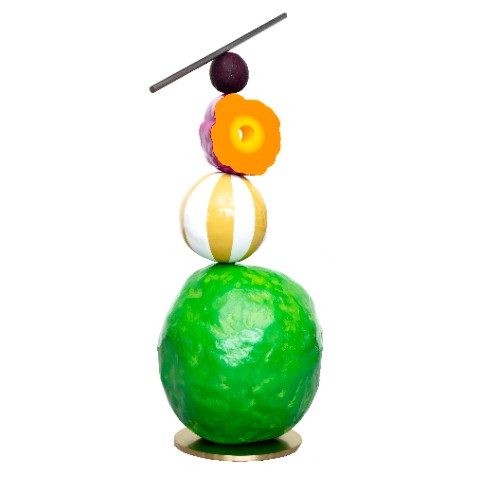
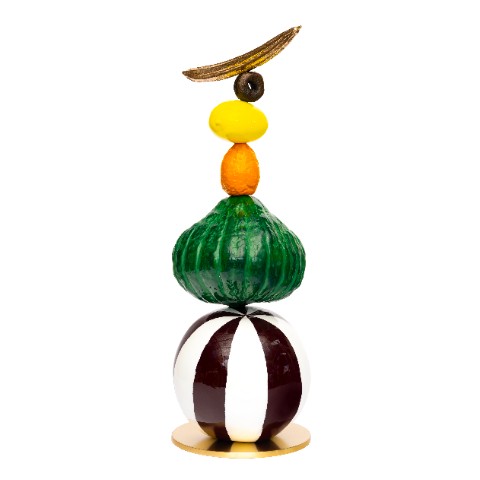
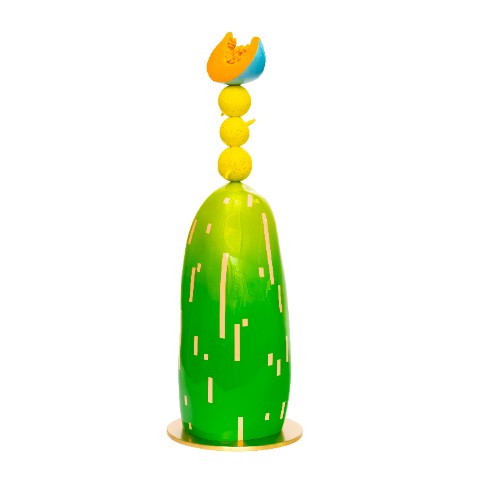
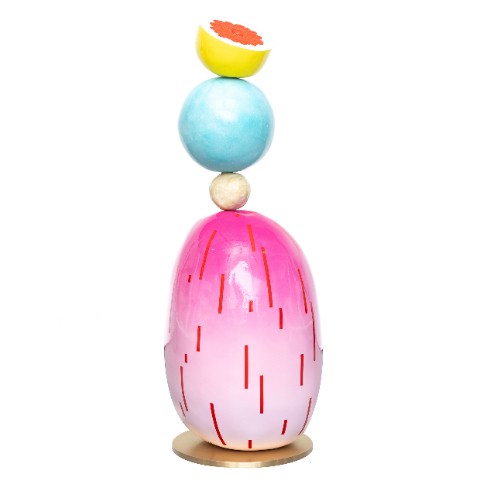
Installation
